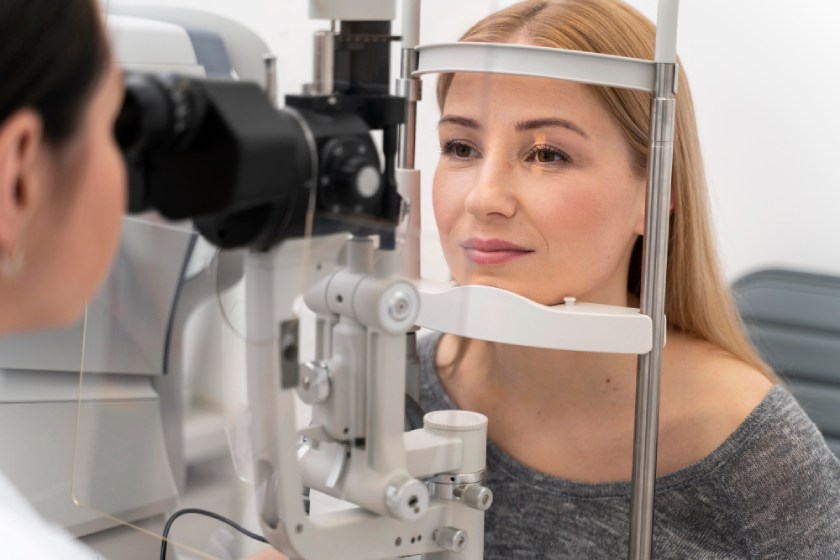When it comes to our health, our eyes often take a backseat despite all the work they do [quite literally!]. In fact, you will be surprised to know that India is home to 62 million visually impaired and 8 million blind individuals. As the country’s population ages, the number of eye-related concerns is only going to grow.
Eckhart Tolle rightly says, “Awareness is the greatest agent for change.” The key to preventing and managing eye concerns is to understand them well—what causes them, how they show up, and what the best treatment option is.
For this reason alone, today we are briefly going to understand the causes, symptoms, and treatment options for 5 of the most prevalent eye concerns in India.
1. Myopia
Commonly known as Nearsightedness, Myopia is a common refractive error. Here, individuals view distant objects as blurry while close objects remain clear. This happens when the eyeball is too long, or the cornea is too curved, causing light rays to focus in front of the retina rather than directly on it.
The World Health Organization predicts that about 3.4 billion people will have myopia by 2030, gradually rising to half the population by 2025!
| Causes | Genetics, and environmental factors like excessive near work or prolonged screen time |
| Symptoms | Difficulty seeing distant objects clearly, squinting, eyestrain [often leading to headaches] |
| Treatment Options | Eyeglasses, contact lenses, or surgery such as LASIK |
2. Hyperopia
This eye condition is just the opposite of Myopia. Here, distant objects appear clear but the objects close appear blurry in vision. It occurs when the eyeball is too short or the cornea has too little curvature, causing light rays to focus behind the retina.
| Causes | Genetics, aging, loss of lens’s flexibility |
| Symptoms | Difficulty focusing on close objects, eye strain, and headaches |
| Treatment Options | Eyeglasses and contact lenses |
3. Cataract
Cataracts are like looking through the clouds—everything appears blurred or hazy. It’s a common age-related problem that affects the eye’s natural lenses.
If not treated in time, cataracts mature. And when that happens, there’s a chance you could go blind. Furthermore, cataract increases the risk of other severe eye conditions, including glaucoma, inflammation, and retinal detachment.
| Causes | Age, congenital, secondary to trauma, certain drugs, exposure to UV radiation, health conditions like diabetes |
| Symptoms | Blurred vision, glare, double vision, difficulty seeing at night |
| Treatment Options | Surgery |
4. Glaucoma
Glaucoma is not a single but rather a group of disorders. Broadly, there are two types—
- Open-angle glaucoma
- Closed-angle glaucoma
Of these two, the latter one is an eye emergency. The former, open-angle glaucoma, is the most common which gradually develops. It is painless and causes no vision changes initially. The bottom line of glaucoma is that it affects your optic [eye] nerve. Although the damage is often related to increased pressure in the eye, it is not a necessary condition.
| Causes | Exact cause is not known. Some reasons could be increased intraocular pressure, age, genetics, and certain medical condition |
| Symptoms | Initially, there are no symptoms. However, as the condition progresses, there can be tunnel vision, eye pain, blurred vision, halos around lights, and nausea. |
| Treatment Options | Eye drops, medications, laser therapy, or surgical procedures |
5. Dry Eye Syndrome
Did you know that not producing enough tears can lead to a problem? Dry Eye Syndrome is all about that. It occurs when either there is not enough production of tears or when the tears evaporate too quickly, leading to discomfort, irritation, and inflammation of the eye surface.
| Causes | Aging, hormonal changes, certain medications, environmental conditions (such as dry or windy climates), long screen time, underlying health concerns like autoimmune diseases |
| Symptoms | Stinging or burning sensations, redness, excessive tearing, blurred vision, light sensitivity, the feeling of foreign particles in the eye |
| Treatment Options | Artificial tear solutions, eye drops, prescription medications, lifestyle modifications like using a humidifier or taking breaks from the screen. In intense cases: Intense pulsed light therapy, scleral contact lenses |
Conclusion
The first step to any problem, including eye conditions, is awareness of what the problem can be. The trick is to identify the symptoms at the right time and know where to take them. But the better trick? Prevention. But more on this in our next read for you!
Until then, take care of those beautiful eyes!

